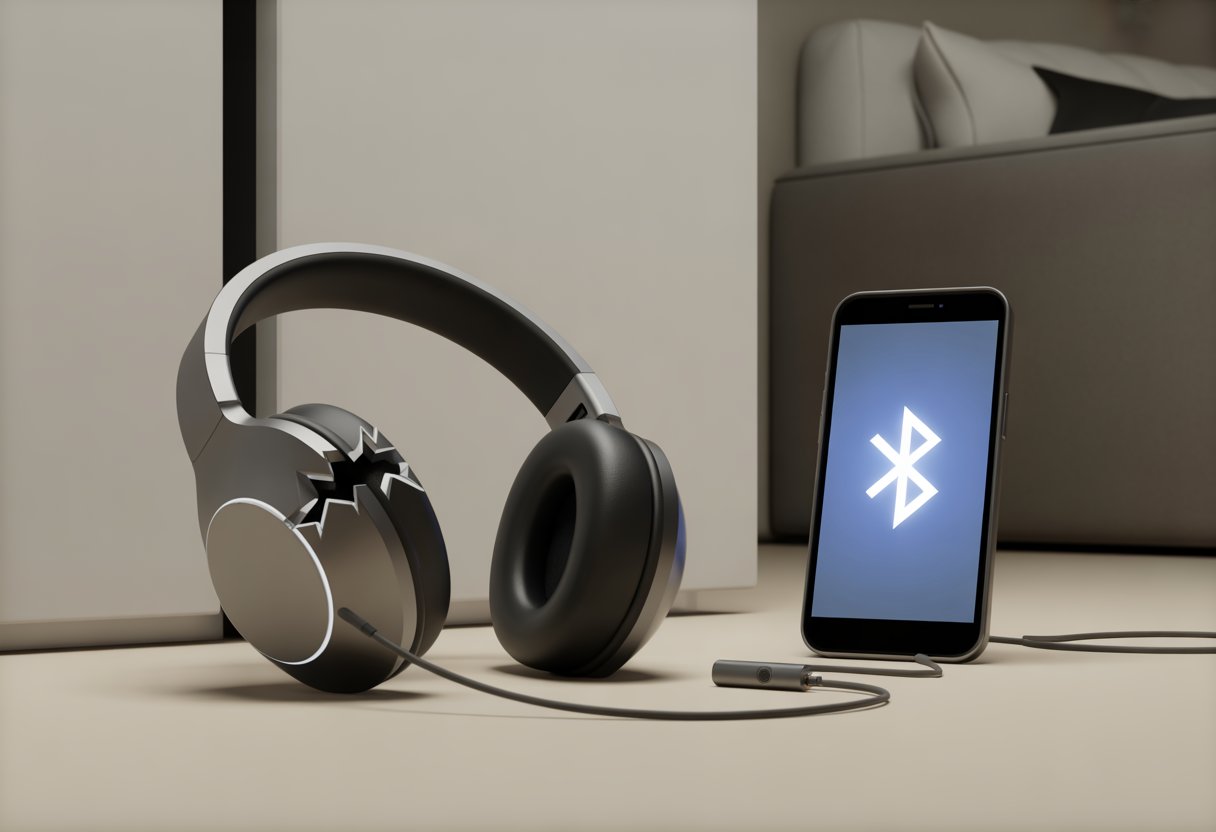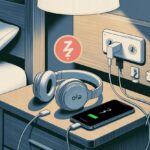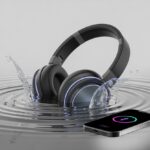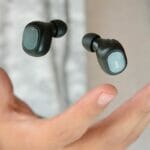Let’s be honest—few things make us panic like watching our expensive Bluetooth headphones hit the floor. We scoop them up, brush off the dust, maybe mutter a quick “please work,” and… silence. Not the peaceful kind, either.
Usually, headphones stop working after a fall because something inside gets knocked loose—a wire, a little speaker part, or who knows what. Even a short drop can mess up these delicate gadgets, especially if they land at the wrong angle.

We’ve all wondered if there’s some secret trick to fix them. Sometimes a reset does the trick, but honestly, the problem is usually physical—those tiny parts inside just can’t handle gravity’s attitude.
Before we start making funeral plans for our headphones, let’s dig into what might have gone wrong and what options we really have for bringing them back (or at least making the surviving earbud feel less lonely).
Immediate Effects of Dropping Bluetooth Headphones
Drop your Bluetooth headphones, and things can go sideways fast. Suddenly, they might feel weird, sound off, or refuse to connect—sometimes all at once.
It’s not just our pride that takes a hit.
Physical Damage Risks
Let’s be real: electronics and gravity are sworn enemies. When our headset falls, the first thing to suffer is usually the delicate hardware inside.
Small parts like wires, drivers, or the battery can get knocked loose or even crack. The outside casing might look tough, but it’s not unbreakable—cracks or dents can show up.
If you hear a rattle or notice the sound getting fuzzy, something probably shook loose inside. Drops can also mess with the microphone, making us sound like we’re calling from underwater.
Table 1: Common Physical Damage
| Part Affected | Possible Issue | Noticeable Sign |
|---|---|---|
| Drivers | Reduced sound quality | Muffled or no audio |
| Battery | Won’t charge | No power |
| Microphone | Distorted audio | Poor call quality |
| Casing | Cracks, dents | Visible damage |
If you hear a rattle that wasn’t there before, congratulations—your headphones just invented a new “feature.”
Loss of Bluetooth Connectivity
Now for the wireless headaches. Sometimes, after a fall, our Bluetooth headphones just refuse to talk to our devices.
Usually, this happens if the impact damages the internal Bluetooth chip or antenna. After a drop, headphones might suddenly lose connection, struggle to pair, or not show up in the Bluetooth menu at all.
Interference and connection drops are more likely if the antenna got bent or disconnected.
Bluetooth issues might show up as:
- Popping or cutting out
- Unstable or lost connections
- Inability to pair with any devices
If your headphones keep dropping the connection, it’s time for troubleshooting or, if you’re really unlucky, a replacement. Sometimes, re-pairing helps, but hardware damage usually needs a pro to fix it. For more on this, check out common Bluetooth connection drops.
Common Reasons Bluetooth Headphones Stop Working After a Fall
When our Bluetooth headphones take a hard landing, the inside can go haywire—even if the outside looks fine.
Connections loosen, parts shift, and sensitive electronics can just quit working in ways that are dramatic but eerily quiet.
Internal Hardware Damage
Let’s be honest. Headphones are tiny machines packed with delicate pieces. Drop them, and those little wires and circuit boards inside can break, crack, or just pop out of place.
It’s the classic “looks okay, sounds terrible” scenario.
Sometimes only one earbud goes silent, or the sound gets weird and fuzzy. The buttons might stop responding if the impact bent something inside.
In really unlucky cases, the tiny speaker disconnects, and you get total silence.
We can’t always see damage from the outside, but the inside tells a different story. If your headphones sound awful after a drop, this is probably why.
Bluetooth Chip Malfunction
Our headphones depend on a tiny chip for all the Bluetooth magic—pairing, connecting, keeping the music playing smoothly. If your buds take a tumble, that chip can get knocked loose or even crack.
A chip out of place causes connection nightmares. Pairing might become impossible, or the headphones could randomly disconnect.
You might notice laggy audio or dropouts that never happened before. In the worst case, the headset won’t even show up in your Bluetooth list.
If Bluetooth issues suddenly pop up—like dropping out or refusing to connect—blame the Bluetooth chip. It doesn’t take much; one unlucky bump can do it.
Battery Displacement or Failure
Power means nothing without a battery. Inside every pair of headphones is a small rechargeable battery tucked carefully in place.
After a fall, the battery can get knocked loose or take damage. When this happens, the headphones might not turn on, or they die super fast.
Sometimes, the charging light stays dark, or the headset shuts off as soon as you unplug it. If the battery gets damaged, it might not charge or will act moody, causing the headphones to be extra unpredictable.
If you’ve ever opened up your headphones (come on, we all have), you might spot the battery shifted or connectors out of place. Without a secure battery, even the best hardware can’t help.
Signs Your Headphones Need Attention (and Not Just a Hug)
We’d all love to think our headphones just need a little TLC after a nasty fall, but sometimes the problems go deeper than a gentle squeeze.
Headphones can act up in ways that are easy to miss but worth catching early.
Broken Power Button
Let’s be real: if the power button doesn’t work, our headphones are just expensive earmuffs.
If the button feels loose, jammed, or just clicks without turning anything on, we’ve got a problem.
Here’s a quick checklist to spot a broken power button:
- Does it wiggle or feel loose?
- Do you have to press it three times harder than usual?
- Is there zero response, even after charging?
A damaged power button usually means something inside got knocked out of place or a connection broke during the fall. If the power LED doesn’t light up or just blinks weakly, something’s definitely wrong.
Tip: Don’t try to pry the button loose with whatever’s nearby (seriously, not even a butter knife). That’s how you turn “broken” into “completely destroyed.”
Unresponsive Controls
When play, pause, or volume buttons suddenly act more stubborn than a cat refusing dinner, it’s a sign of trouble. Unresponsive controls usually mean a drop shook something loose inside.
Maybe only one button stops working, or the touch controls start ignoring you. Here’s what to look for:
- Pressing a button and getting no beep or click.
- Volume buttons suddenly jump to max volume and won’t stop.
- Touch controls pause music randomly or just ignore you.
Internal wiring can get knocked loose from a big fall. If your Bluetooth headphones ignore controls or keep ghosting your fingers, it’s probably a hardware problem from the impact.
Button issues make it tough to enjoy music or take calls, so it’s time to stop hoping for a miracle. Who knew tiny buttons could cause such a headache?
Step-by-Step Troubleshooting for Bluetooth Headphones That Fell
When our headphones hit the ground, their dignity isn’t the only thing that suffers. They might stop working right, but we can try a few things before giving up.
Restarting and Resetting Methods
Let’s start simple: turn the headphones off, count to ten, then turn them back on. Sometimes, that’s all it takes.
If nothing changes, try a factory reset. Most Bluetooth headphones have a reset button or a combo of keys to hold down.
Check your brand’s manual or support page for exact steps. This can clear up weird memory issues or wrong connections after a fall.
Some headphones flash lights or beep during resets. If yours blink like disco balls, that’s usually a good sign. Still stuck? Charge them fully—sometimes a solid power boost helps. More reset tips are in this Bluetooth troubleshooting guide.
Checking Device Manager for Connection Issues
Grab your computer and open Device Manager like a true tech detective. Go to the Bluetooth section and look for yellow warning signs next to your headphones.
If you see trouble, right-click the device name and pick “Uninstall device.” Then reconnect the headphones so the computer can add them again—like a fresh start.
Updating drivers can help, too. Outdated drivers cause more drama than a bad TV show, especially after a fall. Check for updates for your Bluetooth adapter and headphones.
This often gets everything working together again. For more help, see details about solving connection problems in Device Manager.
Testing With Different Devices
Don’t judge your headphones by one failed connection. Try pairing them with a different phone, tablet, or computer.
If they work with another device, your main gadget might be the problem. Testing with more than one device helps figure out if the headphones are broken or just picky.
If they still won’t work anywhere, they probably took a real hit from the fall. Sometimes, reaching out to the brand for a repair or warranty claim is the best move—see stories on Bluetooth earbud support tips.
When To Seek Professional Repair (Or Finally Let Go)
Sometimes it’s tough to tell if our headphones are truly done for or just need a little help. Picking the right next step can save us time, money, and a lot of frustration.
Warranty and Service Options
Let’s be honest—who actually reads the warranty booklet until something goes wrong? If your headphones, headset, or earbuds are still under warranty, you might have lucked out. Lots of brands fix or replace damaged gear for free, as long as you didn’t obviously mistreat it.
Check the warranty policy in the box or just look it up online. It only takes a minute.
Here’s a quick checklist:
| Checkpoint | Why It Matters |
|---|---|
| Warranty still valid? | Repair/replacement may be free |
| Service center nearby? | Faster turnaround |
| Original receipt saved? | Needed for proof |
If the warranty doesn’t cover repairs, some companies will still help out—for a fee, of course. Before shelling out cash, see if it’s cheaper to just buy a new headset, especially if yours has been acting up for a while.
Some brands are more helpful than others. You might need a little patience.
DIY Repair Risks
Who doesn’t love a DIY fix? YouTube makes it look so easy. But when your headphones stop working and you’re tempted to open them up, things can go south fast.
The insides are full of tiny, fragile parts. One wrong move—using the wrong screwdriver or snipping the wrong wire—and you could make things worse.
Risks of going DIY:
- You’ll void the warranty (they always find out)
- You might wreck the speakers or wires for good
- Putting it back together wrong can leave you with rattles or new weird sounds
If you’re cool with the risks, you’ll find plenty of repair guides online. Sometimes, though, it’s better to just let go and shop for something new.
At least then you get that fresh gadget smell. If you’re not sure whether it’s fixable, check out stories from people who dropped their headset and it stopped working. You might pick up some useful tips.
How to Protect Your Headphones From Future Falls
Headphones aren’t built to survive drops. One slip, and you could be shopping for replacements. Protecting them takes a little planning—and maybe not dancing near the kitchen counter.
Using Proper Headset Cases
A sturdy case is basically a helmet for your headphones. Hard-shell cases shield against drops, messy backpacks, and the mysterious liquids lurking at the bottom of your gym bag.
Soft pouches are fine, but for real drop protection, look for padding and a tough exterior.
Foam padding soaks up shocks and keeps delicate parts safe. When you’re picking out a case, check the fit. If your headset moves around inside, it’s not protected.
Extra compartments for cables and adapters help keep things organized. Some cases are waterproof, which is perfect if you’re prone to spills.
More zippers and straps make things even safer. If your headphones didn’t come with a case, it’s worth getting one made for your model.
Safe Storage Tips
Where you keep your headphones matters almost as much as how you carry them. When you’re not using them, stash them somewhere safe—away from table edges or the black hole behind the couch.
A dedicated headphone stand can stop them from falling or getting tangled up. Wrap cords loosely (don’t yank or wind them super tight) to avoid damaging the cable.
Skip hooks on doors or wobbly shelves that pets can bump. Clean, dry drawers or a desk organizer keep dust, sunlight, and moisture at bay.
It helps to always put them in the same spot, so you’re not hunting for them or watching them crash to the floor in slow motion.
For more ways to keep your earbuds safe, check out these tips for keeping earbuds from falling out.
Never Miss a Beat: Getting Back to Your Music After Fixing Headphones
We just survived the great headphone drop of today. Now, let’s get our music back on track—because honestly, who wants to miss their favorite song right at the best part?
First things first, let’s make sure we actually fixed the headphones. Did you check the sound in both ears? It’s never fun to start jamming and realize one side is as quiet as your motivation on a Monday.
Here’s a quick checklist:
- Check the Bluetooth connection. Are we paired up or just talking to ourselves here?
- Test with another device. Maybe the phone’s the real troublemaker.
- Adjust the volume settings. Sometimes it’s just turned way down—those sneaky fingers strike again.
If nothing works, don’t panic yet. Try resetting the headphones using the manual. Most Bluetooth headphones want you to press two buttons at once, which feels like a secret handshake.
If you need help, it’s fine to laugh at yourself while searching for a tutorial.
While you’re at it, maybe pick a new playlist or finally make that legendary mix you’ve been putting off. Honestly, troubleshooting with style is a music lover’s rite of passage.
Soon enough, you’ll be singing along again—hopefully in tune and with both earbuds actually working. And hey, if the music still sounds off, maybe it’s time to think about a new pair (or just blame the band for once).
- Best Bluetooth Headphones for Airplane Travel: Drown Out Crying Babies in Style - December 8, 2025
- How to use Bluetooth headphones with an intercom system and Finally Escape Tangled Wires - December 7, 2025
- Best Fitness Trackers for Silent Alarms: Wake Up Without the Drama - December 7, 2025






